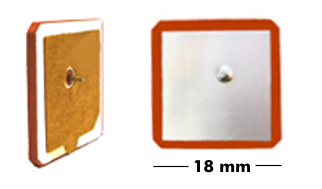patch antenna
Patch antennas are planarantennas used in mobile devices, such as GPS receivers, cell phones and smartphones. Patch antennas or microstrip antennas also include the PIFA antenna, Planar Inverted F-Shaped Antenna.
Patch antennas consist of a carrier material made of polytetrafluoroethylene(PTFE), Teflon( FEP) or epoxy resin, which is laminated on both sides with a conductive material. The bottom side is completely laminated and is at ground potential, while the top side has a laminated rectangle, the patch, which is the resonator for the radiating element. In terms of shape, the resonator can be rectangular, triangular or round. The length of the resonator is tuned to a quarter of the wavelength. At the patch edges, electric field lines are formed towards ground. These support each other, because they are in phase and the field lines at one patch edge run from it to ground, while those at the opposite patch edge run from ground towards the patch edge. The patch antenna is powered by a microstrip or by capacitive coupling.
Patch antennas are used in navigation devices, GSM/GPS modules, smartphones, PDAs, notebooks, netbooks, tablets and other mobile devices. Theirresonant frequency is determined by the length of the patch and the thickness of the carrier material. Patch antennas have 50 ohmimpedance, a standing wave ratio( VSWR) of about 1.3 at 1.5 GHz, and an aperture angle of 90° to 100°. The suppression ratio of front-to-back radiated RF is well over 20 dB.
Patch antennas are characterized by a small size and the manufacturing advantages and can be produced inexpensively using etching technology.

